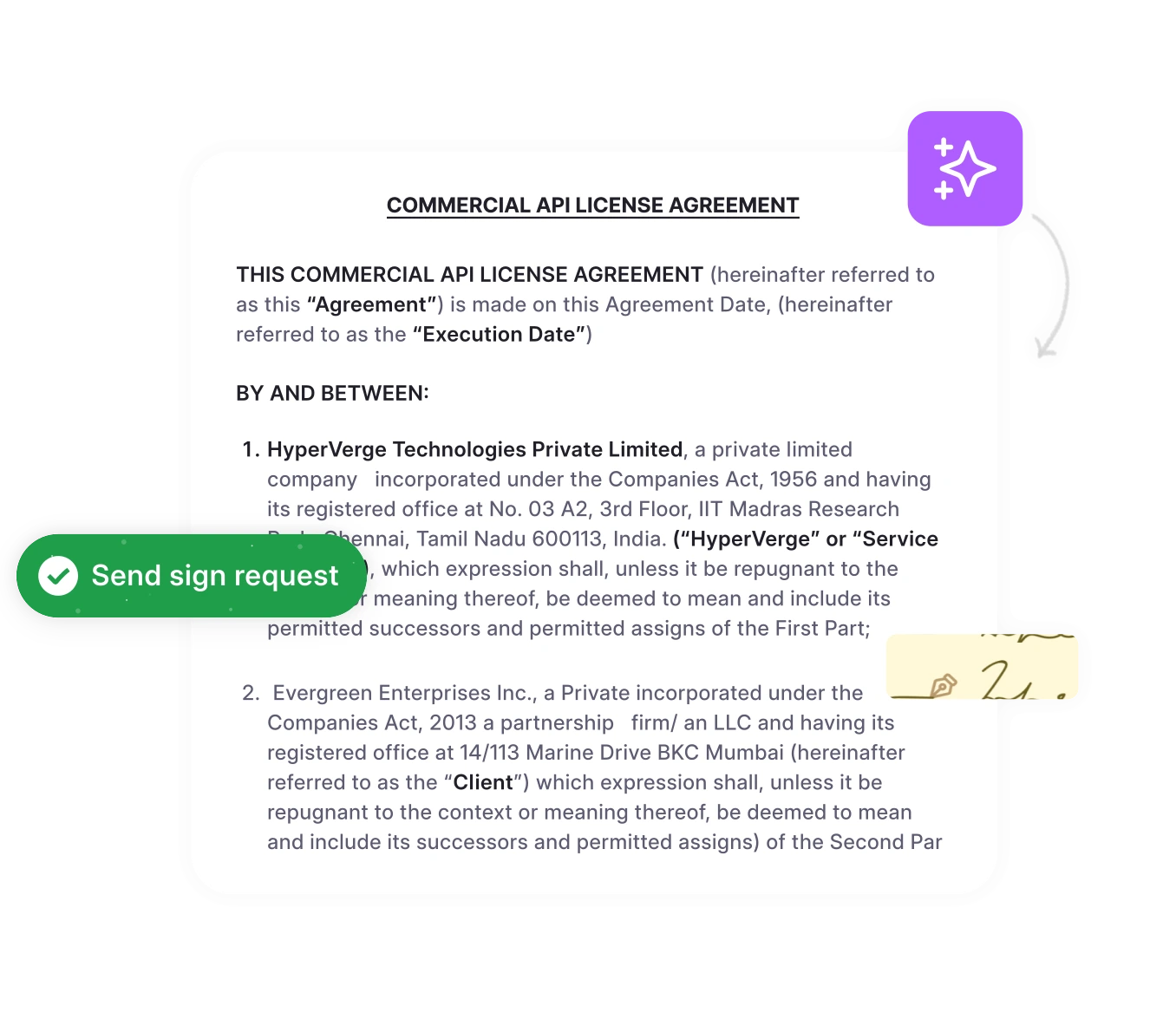Contract conditions are everywhere in your agreements, but managing them shouldn’t be a difficult task. Yet, too often, legal teams lose track of critical deadlines and struggle with unclear condition language that leads to uncertain future events, contract disputes, and wasted time.
That’s where understanding contract conditions becomes essential. By mastering how conditions work—from conditional contracts to special conditions—legal teams can take control of their entire agreement lifecycle. It makes contract review faster, helps teams stay ahead of obligations, and reduces the chance of costly legal mistakes.
In this guide, you’ll discover how contract conditions work, the different types every legal team must know, common pitfalls to avoid, and how CLM transforms condition management.
What are contract conditions?
Contract conditions are specific requirements or events that must happen (or not happen) before your contractual obligations kick in, continue, or end completely. Think of them as switches that alert your attention based on circumstances.
The key difference: Unlike regular contract terms that just say what you’ll do, conditions determine when and if you actually have to do it.
Here’s what real contract conditions involve:
- Triggering obligations: Conditions precedent must be satisfied before anyone has to perform. Like getting a loan approval before buying a house.
- Ending obligations: Termination of duties if certain conditions aren’t met. Like an insurance policy ending if you don’t pay premiums.
- Simultaneous requirements: Concurrent conditions mean both parties must perform at the same time. Like exchanging money for goods at a store.
- Risk management: Every condition shifts risk between parties, determining who bears the consequences if things don’t go as planned.
Now that we understand what contract conditions are, let’s look at the specific types that every legal professional needs to recognize.
What are the 3 conditions of a contract?
Understanding the three core types of contract conditions helps legal teams assess risk, manage deadlines, and prevent disputes:
1. Conditions precedent
It must happen before your contract obligations begin.
You have no duty to perform until these conditions are satisfied. Once they’re met, performance becomes required.
- Real estate: Sale contingent on buyer getting mortgage approval
- Employment: Job offer is conditional on background check clearance
- Business deal: Acquisition requiring regulatory approval
2. Conditions subsequent
Events that END your obligations after they’ve started.
These create ongoing compliance requirements. If triggered, they can terminate agreements that are already in progress.
- Insurance: Policy cancellation for premium non-payment
- Distribution: Territory sales agreement ending targets aren’t met
- Employment: Contract termination upon felony conviction
3. Concurrent conditions
Both parties must perform at the same time.
Neither party has to act unless both can perform simultaneously. Common in point-of-sale transactions.
- Real estate closing: Buyer pays while seller transfers deed
- Asset purchase: Money and ownership change hands together
- Service delivery: Payment terms concurrent with service completion
Condition negotiation strategies for different bargaining positions
| Bargaining Position | Description | Key Strategies | Example Tactics |
| Strong Position | You have high leverage due to market demand, unique offering, or multiple alternatives. | Maximize value while maintaining goodwill. | Set firm terms, offer limited concessions, use deadlines to encourage quick agreement. |
| Balanced Position | Both parties have relatively equal leverage. | Aim for win–win outcomes through collaborative negotiation. | Propose trade-offs, explore mutual interests, and prioritize long-term relationship value. |
| Weak Position | The other party holds more leverage due to the scarcity of options or the urgency on your side. | Protect essential interests and gain incremental benefits. | Focus on non-monetary concessions, extend timelines, and request phased commitments. |
| Emerging Position | Leverage is improving but not yet dominant; typically in growth or early-stage situations. | Build credibility and strengthen your position over time. | Share success metrics, demonstrate unique capabilities, and negotiate flexible terms. |
| Defensive Position | Negotiation aims to prevent further loss or unfavorable terms. | Minimize damage and secure core protections. | Renegotiate risk clauses, limit the scope of obligations, and secure exit provisions. |
Track obligations with AI
HyperStart ensures real-time obligation tracking, automated reminders, and crystal-clear visibility.
Book a DemoIn practice, contract conditions don’t always appear in the same form. Some are clearly written, while others are understood by context. Let’s look at how implied and express conditions differ—and why it matters in legal review.
Express vs. implied conditions: What legal teams need to know
The difference between express and implied conditions affects how you manage risk and enforce agreements.
Here is a detailed table of major differences between express vs. implied conditions mentioned below.
| Aspect | Express Conditions | Implied Conditions |
| Definition | Clear and documented requirements | Hidden liability risks not written or explicitly stated |
| Legal Team Benefits | No guesswork about requirements Easier dispute resolution, Clear deadlines and procedures, Predictable consequences | Not explicitly written anywhere Can create surprise obligations Harder to predict and track Interpretation disputes likely |
| Management Strategy | Use specific, measurable languageInclude realistic deadlines Define satisfaction standards objectively Specify consequences clearly | Document key assumptions explicitly Research industry standard practices Review similar agreements for patterns Add express language for critical assumptions |
| Examples | Buyer’s obligation to close contingent upon property appraisal of at least $450,000 by a certified appraiser within 30 days of contract execution. | Software license agreement implies intellectual property rights which aren’t defined anywhere. |
Stay On Top Of Contract Obligations
Auto-track key dates with HyperStart CLM and never miss an obligation again.
Book a DemoUnderstanding express vs. implied conditions helps legal teams identify all requirements. Now let’s examine the key components that make conditions enforceable.
What legal elements make contract conditions binding?
Creating enforceable contract conditions requires understanding what courts look for when disputes arise. Here is a list of 3 essential legal elements that make contract conditions binding as below:
1. Crystal-clear specificity
Contract conditions must be precise—vague language kills enforceability.
Courts consistently require specific, measurable standards.
- Problematic: “Subject to buyer’s satisfaction of adherence to quality standards”
- Enforceable: “Subject to buyer’s written confirmation that goods meet specifications in Schedule A”
Why specificity matters: Vague conditions give courts no objective standard to apply, leading to unenforceable agreements.
For a contract to be valid, there must be a meeting of the minds. Additionally, it must incorporate the thought process and understanding process of the parties involved.
When the contract evokes vague terms such as “best efforts” or “good faith efforts,” this could have a different meaning to each party. Furthermore, vague contract terms make it impossible for the courts to know what the intent was for both parties. Therefore, the court cannot construe the contract to meet those intents.
2. Legal and achievable requirements
Your conditions must be both lawful and realistically possible to satisfy.
Common problems:
- Impossible deadlines (regulatory approval in 15 days when the process takes months)
- Illegal requirements (conditions violating labor laws or regulations)
- Purely subjective standards without good faith limitations
Better approach: Research actual timelines, include extension provisions, and use objective criteria wherever possible.
3. Good faith performance standards
Legal systems require parties to act honestly when dealing with contract conditions.
This means:
- Cannot deliberately prevent condition satisfaction
- Must make reasonable efforts toward completion
- Cannot manipulate conditions for unfair advantage
- Apply objective standards to subjective requirements when appropriate
Example: If loan approval is required, the borrower must apply for financing and provide accurate information.
Track obligations with AI
HyperStart ensures real-time obligation tracking, automated reminders, and crystal-clear visibility.
Book a DemoEven valid conditions can cause major setbacks if not managed properly. Let’s explore five common pitfalls legal professionals face when drafting or enforcing contract conditions—and how to prevent them.
What are the 5 common contract condition pitfalls (and how to avoid them)
Even well-drafted contracts can fail if conditions are unclear, incomplete, or improperly managed. Here are 5 pitfalls legal teams should watch for and practical ways to avoid them.
1. Vague satisfaction standards
The problem: “Subject to management’s satisfaction with deliverables”
Why it fails: What constitutes satisfaction? Subjective or objective measure? No clear standard to enforce.
The solution: Define specific criteria that survive legal scrutiny—”Subject to written confirmation that deliverables meet requirements outlined in Project Schedule A, such confirmation not to be unreasonably withheld.”
2. Impossible deadlines
The problem: “Contingent upon obtaining all regulatory approvals within 30 days”
Why it fails: Government processes rarely work on tight timelines. Set up automatic condition failure.
The solution: Research actual approval timeframes. Include extension provisions for delays beyond the parties’ control.
3. Missing cure provisions
The problem: Immediate termination rights without opportunity to fix issues
Why it fails: Courts view harsh forfeiture unfavorably. May refuse to enforce one-sided termination rights.
The solution: Include reasonable cure periods—”30-day written notice with opportunity to remedy deficiency before termination rights arise.”
4. One-sided risk allocation
The problem: All conditions favor one party exclusively, with no reciprocal obligations from the other party
Why it fails: Unbalanced agreements face enforceability challenges and negotiation pushback.
The solution: Create mutual conditions protecting both parties’ with SLA conditions, performance metrics, and value-based pricing.
In the construction and industrial sectors, studies reviewing 70 risk factors in project contracts found that ineffective, unbalanced risk allocation frequently results in aggressive claims, conflicts, and costly disputes.
5. Protestative conditions
The problem: Conditions that depend solely on one party’s discretion without objective standards
Why it fails: Purely subjective conditions may be unenforceable as giving one party unlimited exit rights.
The solution: Add objective criteria or good faith requirements—”Subject to buyer’s reasonable satisfaction based on industry standards.”
How to select the right contract condition for your agreement
Start Here: What timing do you need?
Before performance begins? → Use Conditions Precedent
- Best for: Approvals, financing, inspections
- Risk level: Medium (clear start/stop)
During ongoing performance? → Use Conditions Subsequent
- Best for: Compliance requirements, performance standards
- Risk level: High (can terminate valuable agreements)
At the same time as counterparty? → Use Concurrent Conditions
- Best for: Exchanges, simultaneous deliveries
- Risk level: Low (mutual protection)
Let’s explore how CLM software helps legal teams manage contract conditions with greater accuracy and efficiency.
How to manage contract conditions with CLM software
Contract conditions can make or break business relationships, but manual tracking often leads to missed deadlines and compliance failures. CLM platforms transform condition management from reactive chaos into proactive, automated workflows.
1. Smart condition detection and analysis
CLM software automatically scans contracts to identify trigger language like “if,” “subject to,” and “contingent upon.” AI-powered categorization classifies conditions as precedent, subsequent, or concurrent while performing automated risk assessment.
Advanced platforms like HyperStart learn from contract history to continuously improve risk assessment accuracy and suggest better condition structures.
2. Streamlined stakeholder coordination
CLM platforms create automated workflows that route conditional tasks to the right teams. Business teams get feasibility assessments with deadline tracking, while finance teams receive integrated budget checks and cash flow analysis from ERP systems. Compliance automation handles regulatory verification through intelligent database checks.
3. Proactive monitoring and alerts
Smart calendar systems provide escalating notifications before deadlines with automated status reviews. The platform maintains comprehensive audit trails and automated evidence capture. Real-time dashboards give instant visibility into condition status, risk levels, and performance metrics with predictive analytics.
CLM software transforms contract conditions from legal landmines into manageable, trackable business processes that reduce risk and strengthen relationships.
Contract Conditions Checklist
For Every Condition, Verify:
Specificity: Can a third party understand exactly what’s required?
Achievability: Is the timeline realistic given normal processes?
Legality: Does the condition comply with applicable laws?
Fairness: Are risks fairly allocated between parties?
Cure Rights: Can parties fix issues before facing penalties?
Documentation: Are satisfaction standards objective and measurable?
Quick Additional Checks:
Automate your contract obligation tracking
Contract conditions are not limited to party names and payment dates. They include risk positions, clause trends, cycle times, fallback usage, and term variations. It’s business-critical information that’s more than legal admin. They are things to learn from.
Contract conditions determine the success or failure of your business agreements. Manual tracking leads to missed deadlines, compliance gaps, and unnecessary legal disputes.
Before exploring automation, start by understanding what’s already in your contracts. Get foundational insight into approval parties, renewal dates, payment schedules, performance obligations, negotiation trends, and clause alternatives.
Frequently asked questions
Unlike regular contract terms that describe what parties will do, conditions establish the circumstances under which those obligations apply.
Expressly: Through a written agreement specifying waiver scope and effect
Impliedly:: By performing despite a known condition failure or accepting contract benefits after a condition failure
Important:: Document waivers clearly to avoid disputes about scope, timing, and permanence.












